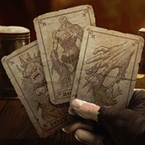In Isaac Jessen's first article for the Rathe Times, he discussed why he brought Lexi to the National Championship in Orlando. Now, he returns for an in-depth discussion on the deck, how he's refined it since that time, and how to navigate every matchup.
Ice Lexi is a very versatile, very powerful deck if you are able to deploy the right lines of play. Most games will play out in the midrange, as even the most aggressive decks will be slowed down by your crippling hit effects and forced to block. Against decks that deploy a defensive strategy, you have the ability to switch gears and build up larger combo turns with Voltaire and Three of a Kind.
The Decklist
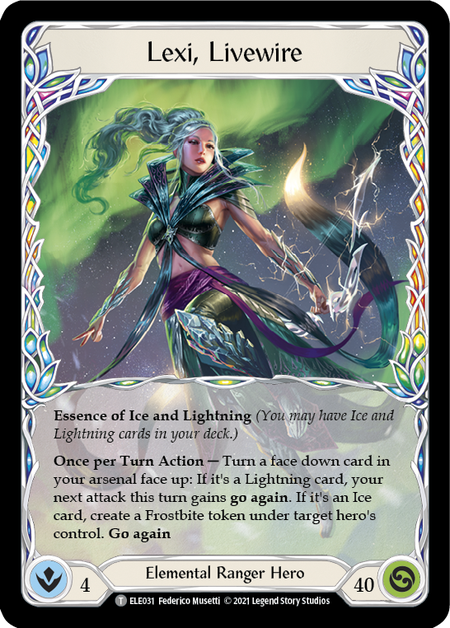
Weapons
- Voltaire, Strike Twice (1)
Equipment
- Perch Grapplers (1)
- New Horizon (1)
- Shock Charmers (1)
- Heart of Ice (1)
- Fyendal's Spring Tunic (1)
- Nullrune Boots (1)
Loadout
- Amulet of Ice (Blue) (2)
- Three of a Kind (Red) (3)
- Blizzard Bolt (Blue) (2)
- Blizzard Bolt (Red) (3)
- Blizzard Bolt (Yellow) (3)
- Channel Lake Frigid (Blue) (3)
- Chilling Icevein (Red) (3)
- Chilling Icevein (Yellow) (3)
- Chilling Icevein (Blue) (2)
- Ice Quake (Blue) (3)
- Flake Out (Red) (2)
- Polar Blast (Blue) (2)
- Ice Quake (Red) (3)
- Frost Lock (Blue) (3)
- Frost Fang (Red) (3)
- Lightning Surge (Red) (2)
- Remorseless (Red) (3)
- Weave Ice (Blue) (2)
- Seek and Destroy (Red) (2)
- Snap Shot (Red) (3)
- Endless Arrow (Red) (3)
- Take Cover (Red) (3)
- Lightning Press (Red) (3)
- Pulse of Volthaven (Red) (1)
- Winter's Bite (Blue) (3)
- Blizzard (Blue) (2)
- Weave Ice (Red) (3)
Your core deck boasts the following ratios:
- 53 cards
- 20 Blues
- 27 Arrows
- 30 Threats
- 23 Ice
- 24 Weave & Pulse targets
- 6 non-elemental arrows
- 12 non-elemental, non ice-cards
Gameplan
In almost every matchup, you will prefer to go first, setting up a six card hand while not giving your opponent a free mulligan. If you are forced to go second, and are not threatened with an oppressive amount of damage, consider paying for Voltaire as an instant to load an arrow on your opponent’s turn. This still allows you to start with a five card hand- which is quite powerful- while beginning the game holding all of the tempo.
In aggressive games, you may find yourself using your life as a resource to gain tempo. You will likely go down in the early game, chipping away your opponent’s armor while setting up for later. Once your opponent has no armor left and no arsenal, you will be able to seize full control of the game and win out. The amount of pressure Lexi can apply in a turn is astounding, especially once your opponent has exhausted their armor blocks.
In the midrange, it is important to recognize if your opponent is mostly choosing to block out, as that may repeatedly be their best line of play. If this is the case, carefully manage your sources of dominate and build bigger turns in order to force through damage. By managing your resources efficiently and building combo turns, Lexi can actually be very difficult to fatigue, despite having no weapon.
Set up turns can be very important. If you notice that you might have an extra resource, sometimes the best play is to pay for Voltaire to load an arrow, and then arsenal an ice card to set up a 6-card hand for next turn. This deck is the king of managing tempo, which is why I enjoy it so much.
You have a number of tools against fatigue. A Frostbite token every turn ensures that playing a defense reaction will cost your opponent two cards, and with patience and planning you can still force damage over your opponent’s defenses. This is no small task, as Rangers can't fall back on their weapon to attack; you have to carefully manage the threat count in your deck.
You will find that there is a certain degree of redundancy in your deck. If you’ve already given your opponent 2 Frostbite tokens, then attacking their hand with Chilling Icevein will be a more threatening play than piling on even more Frostbite. The opposite is also true; if they have pitched a blue card and have two resources floating, then Blizzard Bolt will be more effective at hampering their next turn.
You will need to read your opponent’s motives continuously. If they are trying to keep their hand and have a big turn, dumping your whole hand to attack them may be the right call. However, if they have been happy to block, leave that last card in their hand in favor of setting up for a bigger attack next turn. Ensuring your future turns will be sufficiently threatening is the key to winning with this deck, and taking a single turn off can lose you the game.
Notable Cards
Shock Charmers is a great tool because of the constant threat it presents. Every turn, your opponent must decide whether to block an arrow for 5 or 8 damage with go again. If they do not block, you can dump your hand into pumping Shock Charmers and doubling down on your hit effect. If they do block, then you can simply present another threat on the chain. The ability to duplicate hit effects is very powerful, as well as the ability to pay for damage without it costing you cards out of your deck.
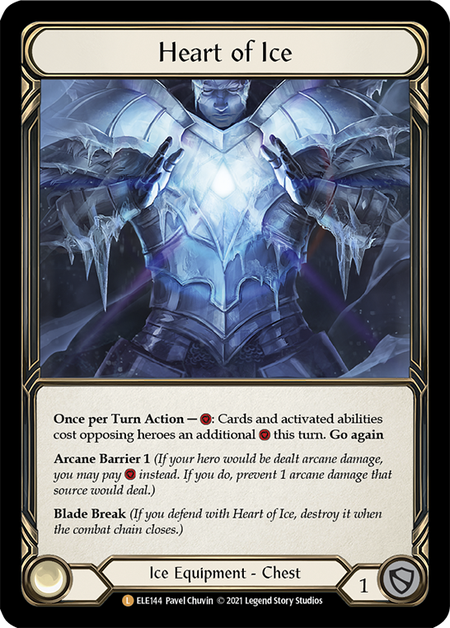
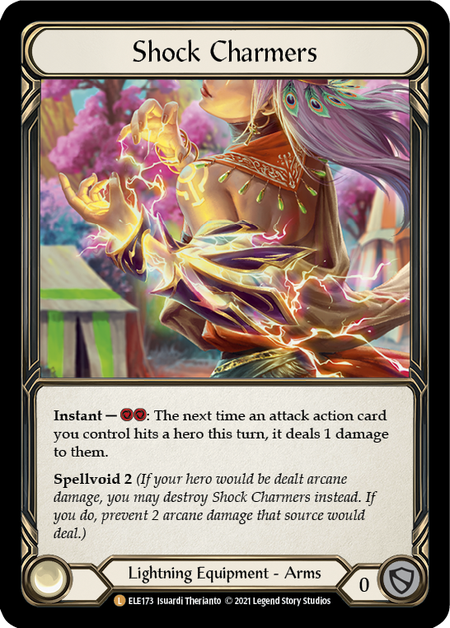
Heart of Ice is only used to combat Oldhim, Prism, and for its arcane barrier against Kano. Most often a Frostbite will be enough to make it uncomfortable for your opponent to play defense reactions, but Oldhim has so many ways to spend resources for defense that using Heart of Ice can really shut out defensive options. It is a difficult piece of equipment to use, as it ups the resource curve of your deck, but its effect pays for itself.
Three of a Kind (ToaK) is a high skill card. It can get you out of a jam by repopulating your hand off of a Tunic resource, but it is important to not get too greedy. It might be a better line to block, play out your Frost Fang, and then arsenal ToaK or pitch it for later. Try to always weigh the risk vs reward when considering this card. If you have a blue arrow, a red pitch card, and a ToaK in hand, pitch the red to play ToaK and save your arrow. ToaK also draws you plenty of resources and fuse cards.
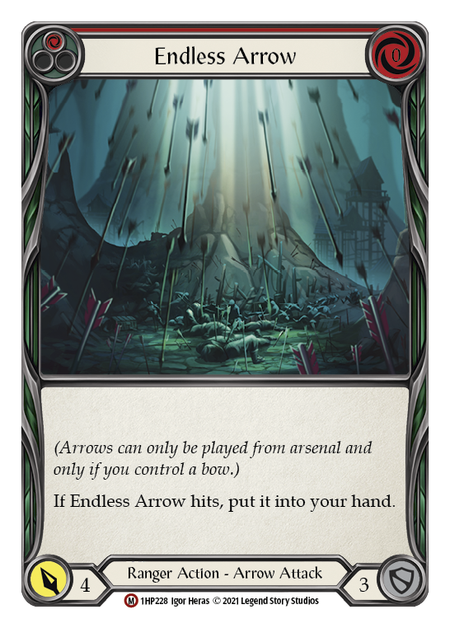

Endless Arrow is extraordinarily versatile. If they allow it to hit, you can fire it at them again or use it to pitch, making it essentially free. You can also arsenal it, threatening a free arrow and free arsenal card turn after turn.
Seek and Destroy is one of my personal favorite cards. It is important in the more aggressive matchups for increasing your hit effect density, while I prefer Lightning Press against more defensive builds. Neither card helps out with any ratio in your deck, but each fills a very important role. Because of the pressure that this deck presents, your opponent will often choose to block out and arsenal a card in order to set up for a better pivot turn. Seek and Destroy addresses this tactic beautifully, making your opponent will be unable to play or arsenal on their turn. Against the hyper aggressive decks, this card attacks your opponent’s ability to arsenal Plunder Run and other crucial combo cards.
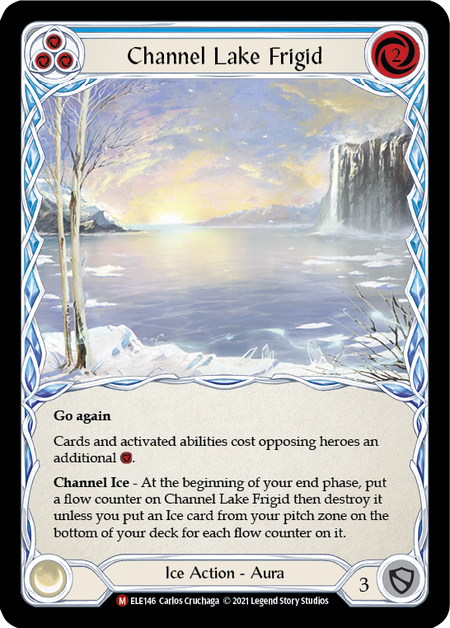
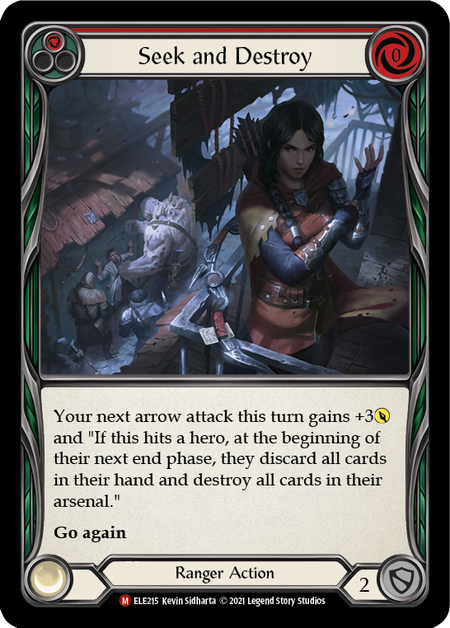
Channel Lake Frigid is a very powerful card at your disposal; but you will most often be presented with the option of either playing it out, or presenting more damage on your turn. Understanding the impact of this card against your opponent can be key to knowing when to prioritize it.
Beyond those key cards, I would encourage anyone piloting this deck to make their own personal adjustments. Everyone’s playstyle is unique and everyone’s meta is different; cater to your strengths.
I would only caution that there are a lot of ratios to consider with Lexi, and trading efficiency for power is a delicate balance to strike. Always remember to consider your number of arrows, number of attacks, number of ice cards, pitch vs cost ratio, and number of cards that synergize with Weave Ice and Pulse of Volthaven.
Lastly, it is important to not have too many of your ratios overlap in some cases. If all of your blue pitch cards are also your ice cards, you will find it hard to both pay for your turn and save an ice card to arsenal. Oftentimes, your ice cards stay in hand through your turn and get played out from arsenal on the next turn; they might as well be red!
Matchup Guide
Before we get into specific matchups, let's talk about general archetypes and how we want to approach each of them.
Anti-Aggro (60 total):
- +2 Blizzard
- +2 Seek and Destroy
- +3 Remorseless
This sideboard prioritizes hit effects over going wide or trying to leak damage. Blizzard works wonders against aggro Katsu and aggro Briar when played correctly, and Seek and Destroy prevents your opponent from being able to build up five card turns effectively. Against decks that go extremely wide, Remorseless can be very cost effective.
Midrange (63 total):
- +2 Blizzard or +1 Amulet of Ice and +1 Weave Ice (blue)
- +2 Seek and Destroy or +2 Lightning Press (red)
- +3 Remorseless or +3 Snap Shot (red)
- +3 Take Cover (red)
This is the sideboard you will play most often, and you'll make those card choices based on your opponent’s most likely strategy. Take Cover is a uniquely powerful card in that it is not a sacrifice to arsenal it; use it to stop your opponent’s powerful hit effect, and then reload an ice card or an arrow without giving up any momentum.
Control, aka- Oldhim (63 total):
- +1 Amulet of Ice
- +1 Weave Ice (blue)
- +3 Lightning Press (red)
- +3 Snap Shot (red)
- +2 Lightning Surge (red)
Your anti-control strategy is primarily for countering Oldhim. Snap Shot and Lightning Surge lower your cost curve, increasing your ability to have bigger and wider turns. Lightning Press is a very affordable way to sneak in hit effects and make your opponent leak damage.
Vs. Brute
The amount of damage that Levia can present can be impressive, and her cost curve is not as vulnerable as some. Your disruption should be enough to hamper her big turns though, and towards the end of the game she will become more and more vulnerable to disruption. Try to pressure the Carrion Husk early, and keep your life total higher than you normally would. This will allow you to have the wiggle room to pressure her later in the game. She will have to choose between taking massive amounts of blood debt damage or Frostbite.
==========
Rhinar can be a surprisingly tough opponent. A more defensive Rhinar build will be happy to block for 9 or 12 and swing back with the club. You need to make sure to keep up the pressure, but also build for bigger turns to get over their defenses. Make sure to utilize your dominate attacks and Three of a Kind turns effectively, and not waste your powerful cards by just swinging for 9-12 damage per turn. If they are on a more aggressive build, you should have an easier time crippling them with your hit effects to carry you through.
Vs. Guardian
Bravo is a tough foe, but once again, with every defense reaction costing him two cards, it becomes much easier to get damage and hit effects through. Bravo also relies on a large hand size and specific cost curve to pivot, so it is important to present enough crippling hit effects every turn so that he cannot successfully play a dominated Crippling Crush or Spinal Crush. If you do get on your heels, block as much as possible, and wait for them to have a more mediocre turn to pivot back. If your opponent is running a more defensive strategy, the inefficiency of their defense reactions along with your ability to build bigger turns should carry you through to victory.
==========
The matchup against Oldhim is certainly your toughest. Oldhim has the ability to pivot with very powerful attacks if you give him any breathing room, so maintaining pressure here is key. In addition, he is very good at mitigating damage with Crown of Seeds and Rampart of the Ram's Head. Giving him a Frostbite every turn helps make his defense reaction cards more expensive to play- but with so many defensive resource sinks available, this will not be enough.
Your gameplan needs to be a constant balance of maintaining pressure to maintain momentum, building bigger combo turns in order to leak damage through, and pitching for your second cycle. In addition, it is important to maintain a high enough life total that you are able to play out your bigger second cycle hands when the time comes. Heart of Ice and Channel Lake Frigid can be crippling to Oldhim’s game plan when you can afford them, but it is important to be able to capitalize on these abilities by pushing damage on that turn.
Vs. Illusionist
Attacking Prism’s cost curve is effective enough to give you an edge in this matchup, and your ability to go wide makes her auras manageable. So long as they don’t draw really hot with an aggressive Herald build, you will be able to have favorable damage exchanges while attacking their cost curves. Use Heart of Ice at the beginning of every turn in which you can afford it; this way, if they are forced to respond by playing out an aura, you can then destroy it. It is important to take note of the unique interaction between Merciful Retribution and Frostbite tokens, and prioritize destroying this aura above all else.
Vs. Mechanologist
This is one of your hardest matchups. Your Frostbites help mitigate their defense reactions, but oftentimes you will find it hard to threaten enough Frostbite tokens and card strip effects to truly cripple their turns. Dash plays a lot of blues, a very consistent weapon, and above-curve attacks with the boost mechanic. You will need to carefully manage your life exchanges throughout the match and capitalize on your bigger turns to gain momentum.
Vs. Ninja
As with many of the heroes, you could face several different archetypes of Katsu. Against a more aggressive build, you should have no trouble blocking their Mask of Momentum triggers and seizing tempo. Attacking their hand and cost curve is particularly crippling for Katsu, and Frostbite makes their defense reactions inefficient to play. Blizzard works wonders in this matchup. If they are playing a more defensive build, your Frostbite will become even more effective, making their defense reactions cost two cards out of their hand. Try to identify which archetype your opponent is playing early and adjust so as not to waste your resources. You should be able to present enough damage to leak some through every turn if they need to pay one every time they need to use a defense reaction.
Vs. Ranger
Ranger vs. Ranger matchups are always scary. Having no armor on either side means that you are both very vulnerable to every hit effect. In general though, Lexi has more consistent ways to dominate, go wide, and threaten on-hit triggers. Azalea also tends to run a fairly red line deck, so Frostbite will really hamper them. Vie for tempo, and when Azalea has a less threatening turn (i.e. Hamstring Shot or Searing Shot) use your life as a resource to come back at them with a more devastating turn. Lexi’s ability to present constant pressure will allow you to maintain momentum throughout the match.
==========
Try to take the 2nd play. Going into this matchup, you will not know whether you are facing a Lightning Lexi or an Ice Lexi. Lightning Lexi is similar to your other aggro matchups and is pretty straightforward. Ice Lexi can be very tough, as your hit effects can be very crippling to each other and neither of you have any armor. Maintaining momentum in this matchup is paramount, as even with a significant life lead it is very difficult to have a turn if you have no momentum. Channel Lake Frigid can be particularly potent against Lexi, as her machine requires a lot of activations to be effective.
Vs. Runeblade
This match is straightforward. You will likely go down on life while working your way through their armor and hampering them as best you can. Once you have a window (i.e. their armor is mostly gone, they have no arsenal, you have a particularly powerful hand set up, they don’t have many Embodiment of Earth tokens, etc. ), you can use your life as a resource and pivot. After this point you will have control of the game and be able win, as their deck does not block well once they are unable to create Embodiment of Earth tokens. The hybrid Briar builds are a little bit more resilient to your pressure, but you still have more than enough pressure in the deck to make this a favorable matchup.
==========
This can be a difficult matchup. Chane is very powerful in this meta, and more resilient than Briar to your forms of pressure. Their card advantage can give them an edge, but mixing up your hit effects can still apply enough pressure to dampen their turns. Since the ban of Seeds, however, Chane’s banishes every turn- as well as cards like Shadow Puppetry- are less threatening. As the Shackles build up, Chane will become more powerful, so constant pressure is a must in this matchup. Try to race and win the match before Chane can build up to his full power.
==========
Viserai can play a variety of tempos, but odds are you will be facing some sort of midrange gameplan. Take Cover works wonders here, as stopping a Mauvrion Skies + Meet and Greet with one card mitigates a lot of damage. Try to take note of how many discounted cards your opponent is running, as sometimes you may want to prioritize stripping cards over giving Frostbite. Your attacks will be more threatening than theirs, and you should be able to seize tempo.
Vs. Warrior
Whether your opponent is playing the combo build or a more aggressive one, your hit effects and constant pressure should be more than enough to shut them down. The aggro match plays out like most do, and you may have to take some early damage to set up, work through their armor, and seize momentum. If they are playing the Lumina Ascension combo build, you should be able to cripple them enough so that they are not able to pull off their combo once they have built up to it. If this is the line they are taking, it is important to prioritize constant pressure over big turns, so make sure that you set up your next turn appropriately.
==========
Dorinthea can be a very intimidating opponent, and will likely give you trouble in the early game. However, once you have worked your way through her armor, your attacks will become very detrimental to her gameplan. This is the rare matchup where you want to take 2nd. You will be forcing her to play a midrange game with you, and her attacking power will go down drastically. Whenever calculating your blocks against Dorinthea, remember that she does have a fairly low damage ceiling compared to some other heroes, especially with reprise turned off. After the early game, it will become more important to trade damage and hit effects than to try and block her out. Once you have momentum, Dorinthea will find it difficult to block out enough of your hit effects and still have a productive turn.
Vs. Wizard
This is a very favorable matchup for Ice Lexi. Giving Kano a Frostbite every turn attacks their already horrendous cost curve. They will have to decide whether they want to top deck on your turn in response to the Frostbite, or face even more debilitating hit effects before going into their turn.




